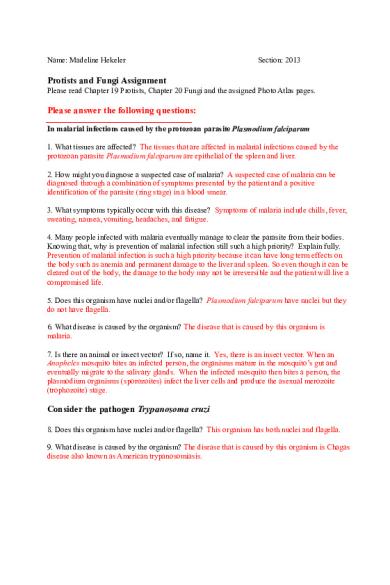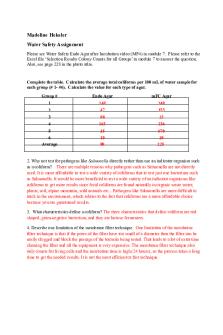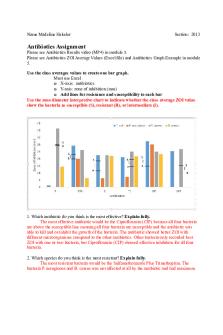bio 245 Protists & Fungi assignment PDF

| Title | bio 245 Protists & Fungi assignment |
|---|---|
| Author | Maddy Hekeler |
| Course | General Microbiology (2, 4) |
| Institution | James Madison University |
| Pages | 3 |
| File Size | 123.6 KB |
| File Type | |
| Total Downloads | 17 |
| Total Views | 145 |
Summary
Dr. Powers comprehensive notes...
Description
Name: Madeline Hekeler
Section: 2013
Protists and Fungi Assignment Please read Chapter 19 Protists, Chapter 20 Fungi and the assigned Photo Atlas pages.
Please answer the following questions: In malarial infections caused by the protozoan parasite Plasmodium falciparum 1. What tissues are affected? The tissues that are affected in malarial infections caused by the protozoan parasite Plasmodium falciparum are epithelial of the spleen and liver. 2. How might you diagnose a suspected case of malaria? A suspected case of malaria can be diagnosed through a combination of symptoms presented by the patient and a positive identification of the parasite (ring stage) in a blood smear. 3. What symptoms typically occur with this disease? Symptoms of malaria include chills, fever, sweating, nausea, vomiting, headaches, and fatigue. 4. Many people infected with malaria eventually manage to clear the parasite from their bodies. Knowing that, why is prevention of malarial infection still such a high priority? Explain fully. Prevention of malarial infection is such a high priority because it can have long term effects on the body such as anemia and permanent damage to the liver and spleen. So even though it can be cleared out of the body, the damage to the body may not be irreversible and the patient will live a compromised life. 5. Does this organism have nuclei and/or flagella? Plasmodium falciparum have nuclei but they do not have flagella. 6. What disease is caused by the organism? The disease that is caused by this organism is malaria. 7. Is there an animal or insect vector? If so, name it. Yes, there is an insect vector. When an Anopheles mosquito bites an infected person, the organisms mature in the mosquito’s gut and eventually migrate to the salivary glands. When the infected mosquito then bites a person, the plasmodium organisms (sporozoites) infect the liver cells and produce the asexual merozoite (trophozoite) stage.
Consider the pathogen Trypanosoma cruzi 8. Does this organism have nuclei and/or flagella? This organism has both nuclei and flagella. 9. What disease is caused by the organism? The disease that is caused by this organism is Chagas disease also known as American trypanosomiasis.
10. Is there an animal or insect vector? If so, name it. Yes, there is an insect vector known as the “kissing bug” because of the bites found on the patients face 11. Name one way that the disease is transmitted to humans. One way that the disease is transmitted to humans is once they get bit, they often rub the feces into the by wound or other skin abrasion they may have. The microorganism grows in the gut of the bug and is passed on through their feces. 12. List two differences between cysts and trophozoites. The cyst form is spherical or ovoid shape and they are dormant, thick-shelled, and resistance to the environment. The trophozoites are motile with flagella or cilia and are considered the feeding stage of the life cycle. Trophozoites are also pear-shaped or flat oval. 13. Why do many obstetricians advise that pregnant women should not clean the kitty litter box? Explain fully. Many obstetricians advise that pregnant women should not clean the kitty litter box because feces can contain a parasite that causes toxoplasmosis infection. If a pregnant woman gets toxoplasmosis, it will not only affect themselves but can be passed along to their baby. This can cause a miscarriage or a stillbirth which is a traumatic experience for both mother and child. The baby could also experience brain damage and liver damage. 14. Why are children at special risk of infections with organisms that are transmitted by the fecal-oral route? Explain fully. Children are at special risk of infections with organisms that are transmitted by the fecal-oral route because kids constantly have contaminated palms. They are always playing with things and then sticking their hands and fingers in their mouth that can have microorganisms on them that cause infection and disease. This is especially common in groupdaycare settings, where fecal organisms are commonly found on surfaces and on the hands of providers. These can spread directly through a group-care setting quite quickly, often spreading by fomites. Swimming pools and water parks can also be locations of fecal–oral transmission and just getting the water in the mouth can cause an infection.
Consider the pathogen Trichomonas vaginalis 15. Does this organism have nuclei and/or flagella? These organisms have both nuclei and flagella. 16. What disease is caused by this organism? The disease that is caused by this organism is trichomoniasis, an infection of the vulva and vagina in humans. 17. Name one way that the disease is transmitted to humans. One way that the disease is transmitted to humans is through sexual intercourse. If one person is infected they can spread the disease to the other during intercourse. 18. Is there an animal/insect vector? If so, name it. There are no animal/insect vectors for Trichomonas vaginalis.
Answer the following questions related to fungi: 19. Describe how you might be able to differentiate Rhizopus nigricans from Aspergillus niger by simply observing a petri dish culture. Explain fully. Rhizopus species produce a white or grayish cottony growth because the mycelium becomes darker with age as sporangia are produced, giving it a salt and pepper appearance. Rhizopus are fruiting bodies are attached to the inside of the lid because of the presence of stolons. Aspergillus niger produce destinctive black colonies with chains of conidia arising from one or two rows of phialides attached to a swollen vesicle at the end of an unbranched conidiophore. Aspergillus niger are not found on the lid of the petri dish. 20. How can you distinguish Aspergillus from Penicillium? Include two differences, one microscopic difference and one macroscopic difference. Color is not a microscopic difference. A microscopic difference between Aspergillus from Penicillium, is in Aspergillus the conidiophore is straight ending in a large vesicle from which primary and secondary sterigmata arise bearing conidia in chains while Penicillium has branches conidiophore with medulla and sterigmata on which conidia are born in chains. A macroscopic difference is that Penicillium is a blue mold where Aspergillus differs in color from green to black. 21. Give one example of a medically important fungus, and the disease and/or symptoms caused by the fungus. Blastomyces dermatitidis is a fungus that causes blastomycosis. Blastomycosis is a respiratory infection that has symptoms such as fever, cough, night sweats, muscle aches or joint pain, weight loss, chest pain, fatigue. 22. How can you distinguish a mold colony from a bacterial colony? Explain fully. Bacterial colonies are smoothe and slimy and are typically white, cream, or yellow in appearance and are relatively circular. Mold colonies are large, fuzzy, and become different colors and they grow outwards from their centers. 23. In a laboratory setting, how can you distinguish between a yeast cell and a bacterial cell? Explain fully. The difference between a yeast cell and a bacterial cell is that a bacteria cell is prokaryotic and yeast cells are eukaryotic. Prokaryotic and Eukaryotic have different organelles that can be observed in a laboratory setting. Yeast cells have membrane-bound organelles, but bacteria has no membrane-bound organelles. Yeast has a single nucleus per cell, but bacteria do not have a nucleus...
Similar Free PDFs

Lect7 Protists Fungi Notes
- 4 Pages

bio 245 Lab 8 worksheet
- 3 Pages

bio 245 Lab 11 worksheet
- 2 Pages

Makalah Fungi
- 11 Pages

Reino Fungi
- 4 Pages

LAB 4 - protists
- 18 Pages

Worksheet Protists - Homework
- 8 Pages

Item 245 – Diabète - ECN
- 15 Pages

Fungi + Sketchy
- 4 Pages

245-CAN Centes
- 21 Pages

Bio Assignment 5
- 4 Pages

Bio Assignment 2A
- 3 Pages
Popular Institutions
- Tinajero National High School - Annex
- Politeknik Caltex Riau
- Yokohama City University
- SGT University
- University of Al-Qadisiyah
- Divine Word College of Vigan
- Techniek College Rotterdam
- Universidade de Santiago
- Universiti Teknologi MARA Cawangan Johor Kampus Pasir Gudang
- Poltekkes Kemenkes Yogyakarta
- Baguio City National High School
- Colegio san marcos
- preparatoria uno
- Centro de Bachillerato Tecnológico Industrial y de Servicios No. 107
- Dalian Maritime University
- Quang Trung Secondary School
- Colegio Tecnológico en Informática
- Corporación Regional de Educación Superior
- Grupo CEDVA
- Dar Al Uloom University
- Centro de Estudios Preuniversitarios de la Universidad Nacional de Ingeniería
- 上智大学
- Aakash International School, Nuna Majara
- San Felipe Neri Catholic School
- Kang Chiao International School - New Taipei City
- Misamis Occidental National High School
- Institución Educativa Escuela Normal Juan Ladrilleros
- Kolehiyo ng Pantukan
- Batanes State College
- Instituto Continental
- Sekolah Menengah Kejuruan Kesehatan Kaltara (Tarakan)
- Colegio de La Inmaculada Concepcion - Cebu



